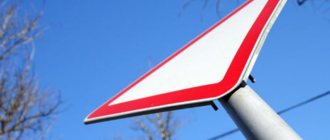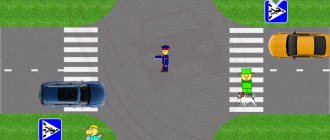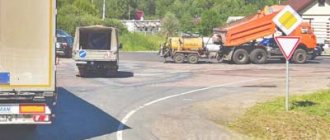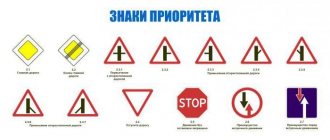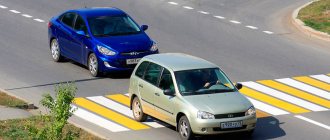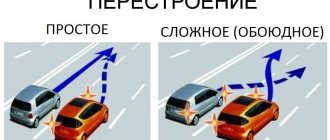Traffic rules terms and definitions
“Shoulder” is an element of the road adjacent directly to the roadway at the same level with it, differing in the type of surface or marked out using markings 1.2 (white solid line) used for driving, stopping and parking in accordance with the Rules.
“Obstacle” is a stationary object in the traffic lane (faulty or damaged vehicle, roadway defect, foreign objects, etc.) that does not allow further movement along this lane. A traffic jam or a vehicle stopped in this lane in accordance with the requirements of the Rules is not an obstacle.
“Main road” - a road marked with signs 2.1, 2.3.1 - 2.3.7 or 5.1, in relation to the one being crossed (adjacent), or a road with a hard surface (asphalt and cement concrete, stone materials, etc.) in relation to the dirt road , or any road in relation to exits from adjacent territories. The presence of a paved section on a minor road immediately before the intersection does not make it equal in importance to the one it intersects.
If I was driving along the main road, and in front of the intersection there is a sign for the end of the main road and a sign changing the direction of the main road (such a mistake, unfortunately) which shows that I am on a secondary road. What to do in this case? If the sign itself says that I am at the crossroads of equivalent roads?!
Also, a sign indicating a secondary road is “No driving without stopping”. In this case, you need to stop, make sure that there are no cars on the main road, and only then continue driving. By following the instructions of these signs, vehicles moving along the main road will be able to move freely.
In populated areas, the “Main Road” sign is duplicated because it does not have its own coverage area. That is, it indicates priorities only at the intersection in front of which it is located. But if the sign is placed after it, then its effect is established for the entire section of the road.
“Advantage (priority)” and “Give way (do not interfere)” are interrelated terms: if one already has an advantage, then the other must give way. It is only important that in any situation all road users accurately determine their status: who you are now - “first” or “second”.
It is quite possible that you have a question: “Why should you give in to someone on the right and not on the left?” This requirement of the Rules is nothing more than a consequence of right-hand traffic adopted in our country. Agree that your distance to the point of collision is greater than that of the driver of the gray car, that is, it is easier for you to comply with the “Give way” requirement. Tell me, will you now give way to a gray car? He's still on your right!
Traffic Laws
If a secondary road intersects or does not adjoin a main road at a right angle, on the signs Intersection with a minor road, Junction with a secondary main road (1.56, c) this may be shown at the appropriate angle depending on the configuration of the intersection.
The admissibility of any violations of signs 2.3.2 – 2.3.7 is not provided, except for the cases of selecting a speed limit and giving a turn signal to maneuver at an intersection. But for drivers approaching the main road, a number of requirements are regulated. Firstly, do not interfere with traffic on the main road.
For drivers who move in the direction designated as the main road, traffic rules require priority (primary) movement through uncontrolled intersections and intersections with secondary directions. Drivers traveling in a secondary direction are required to yield to traffic moving in the main direction. At controlled intersections, you should be guided by the signals given by the traffic controller or traffic light.
Before the intersection with the main road, sign 2.5 may be placed, which prohibits passing without stopping. 2.5 obliges you to yield to vehicles traveling on the roadway you are crossing. Drivers must stop at the stop line, and when there is none, at the border of the intersection. Only after making sure that further movement is safe and does not interfere with transport in the direction being crossed can you move off.
13.12. When turning left or making a U-turn, the driver of a trackless vehicle is obliged to give way to vehicles moving on an equivalent road from the opposite direction straight or to the right. Tram drivers should follow the same rule among themselves.
Once again, I want to remind you that when approaching any intersection, you must first take the correct lane and then decide on the type of intersection. Well, within the framework of this article we will consider an unregulated intersection, to which a car is approaching along a secondary road:
Rules for driving through unregulated intersections
The advantage of the tram . A tram at an uncontrolled intersection has an advantage over trackless vehicles only when it moves along the main road or is on equal roads with them. If a tram approaches an intersection along a secondary road, then it gives way to trackless vehicles traveling on the main road.
If you cannot see the signs of regulation of the intersection from afar, then, if necessary, slow down and drive closer to the intersection. You see that the traffic light is not working, there is no traffic controller, and in your direction there is a sign 2.1 “Main Road”. This means that in front of you is an intersection of unequal roads, and you are moving along the main road.
KarpOff-270 › Blog › Topic 1
Rules. Section 1. “Main road” - a road marked with signs 2.1, 2.3.1 - 2.3.7 or 5.1 in relation to the one being crossed (adjacent), or a road with a hard surface (asphalt and cement concrete, stone materials, etc.) in relation to to a dirt road, or any road in relation to exits from adjacent territories. The presence of a paved section on a minor road immediately before the intersection does not make it equal in importance to the one it intersects.
Formally, the driver is now also overtaking. Only the Rules do not call any overtaking within one’s half of the roadway overtaking, but rather overtaking
. And, by the way, ahead, unlike overtaking, is never prohibited by the Rules. If only the driver, at the time of advancing, does not violate the speed limit established on this section of the road.
For drivers who move in the direction designated as the main road, traffic rules require priority (primary) movement through uncontrolled intersections and intersections with secondary directions. Drivers traveling in a secondary direction are required to yield to traffic moving in the main direction. At controlled intersections, you should be guided by the signals given by the traffic controller or traffic light.
Before the intersection with the main road, sign 2.5 may be placed, which prohibits passing without stopping. 2.5 obliges you to yield to vehicles traveling on the roadway you are crossing. Drivers must stop at the stop line, and when there is none, at the border of the intersection. Only after making sure that further movement is safe and does not interfere with transport in the direction being crossed can you move off.
What is a secondary road definition
For drivers who move in the direction designated as the main road, traffic rules require priority (primary) movement through uncontrolled intersections and intersections with secondary directions. Drivers traveling in a secondary direction are required to yield to traffic moving in the main direction. At controlled intersections, you should be guided by the signals given by the traffic controller or traffic light.
You may be interested in:: Can Bailiffs Seize My Husband’s Car?
Hello, please tell me what is the best thing to do in this situation. I leave the secondary road and turn left, and the oncoming car (number 3), which is also on the secondary road, also turns left. We pass each other, but what if there are others behind this car (number 3) who are going straight or to the left? In this situation, should I wait or should I simultaneously enter the intersection with the car (numbered 3) that is also turning left and let the cars behind it pass?
How to determine the main and secondary roads
If, approaching an intersection, you see a “Give Way” sign, then know that you are driving on a secondary road. In this case, you must definitely give way to vehicles traveling through the terrain being crossed. Only after you are sure that there are no cars on the main road can you continue driving.
- "The main road". This sign can most often be seen at uncontrolled intersections. A car driving under such a sign has an advantage over other road users.
- "The end of the main road." Such a sign is located immediately before the intersection and means that the previously existing advantages are no longer available.
- “Intersection with a minor road” and “Adjacent to a minor road”. These related signs are mainly installed outside the populated area. They mean that motorists at the intersection will have priority over vehicles traveling along the road being crossed.
- "Give way." Unlike the above signs that give priority, it, on the contrary, means that motorists must give way to vehicles moving on the main road.
- “Driving without stopping is prohibited.” It is simply impossible to confuse this sign with any other, since it is the only one of all that has an octagonal shape. When the driver sees him, he must make a mandatory vehicle stop.
- “Advantage to oncoming traffic” and “Advantage to oncoming traffic.” These signs have the opposite meaning. The first of them obliges vehicles to pass, and the second, on the contrary, indicates priority in traffic.
Traffic rules terms and definitions
“Safety island” is an element of the road arrangement that separates traffic lanes (including lanes for cyclists), as well as traffic lanes and tram tracks, structurally separated by a curb stone above the roadway or marked by technical means of traffic management and intended to stop pedestrians when crossing the roadway. The traffic island may include part of the dividing strip through which a pedestrian crossing is laid.
“Road” is a strip of land or a surface of an artificial structure equipped or adapted and used for the movement of vehicles. The road includes one or more carriageways, as well as tram tracks, sidewalks, shoulders and dividing strips, if any.
- 2.1 is placed at the beginning of the segment with priority right of movement through, as well as immediately before intersections.
- If at the intersection the main road changes direction, then in addition to 2.1, a sign 8.13 is installed.
- The end of the section where the driver was driving along the main road is indicated by sign 2.2.
- 2.3.1 informs about the approach to the intersection with directions of secondary importance simultaneously from the left and right.
- 2.3.2–2.3.7 – about approaching the junction on the right or left of a secondary road.
- The sign “Motorway” (5.1) indicates the main road to which the rules for traveling on motorways apply. 5.1 is placed at the beginning of the highway.
When constructing onshore transport and storage facilities for oil, petroleum products and gas, the road network at the construction site consists of main and secondary roads. Main highways are designed in areas with the most intense traffic; they must have a width of at least 6 m and provide two-way traffic flow, as well as bypass for vehicles standing under unloading. These roads are provided with widenings necessary for passing oncoming traffic and for ensuring the passage of vehicles during unloading in the crane's operating area. Main and secondary roads should not be designed as dead ends. As an exception, the construction of dead-end secondary roads is allowed with the obligatory organization of areas for turning vehicles.
To mark adjacent roads, signs are used in the form of white equilateral triangles, with a red border around the perimeter, with an image of the road situation in the center. They are installed on the main road to inform drivers about possible situations for making the desired maneuver.
I would be very grateful if you could comment on the rules for driving on a secondary road at an “offset” intersection. The situation is this: the main street (A) goes straight, two secondary streets (B and C) adjoin it at different levels. Apparently there is only one intersection (a cross-shaped one, not two T-shaped ones), since the main road signs are not duplicated (they are installed earlier before the pedestrian crossings). Here, in fact, are the coordinates of this intersection: 55.750234, 37.985991 (in Yandex maps I recommend using the “hybrid” mode; you can also see panoramas of this intersection in Yandex). The shift when driving on secondary roads (B-V and V-B) occurs to the left. The problem is this: often drivers, when turning left from secondary roads (from B to A or from B to A), believe that they have an advantage because, after turning, they drive 2-3 meters along the main road. At the same time, other drivers (I am one of them) believe that when driving on secondary roads, those who move straight (from B to B and vice versa) should have priority. (Naturally, the need to give way to everyone driving along A is not discussed from the very beginning.) Explain who should give way to whom at such an intersection: Those who move from B to C (and vice versa), or those who turn from B (or B) on A to the left. Thank you very much in advance!
- When turning right, we give way to the vehicle on the left (blue car) and to oncoming traffic (green), if they are going in the same direction as us.
- When moving in a forward direction, it is necessary to give way to those on the left, to oncoming people, because they are driving on the main road, and also to the right (black car), although they are also on the secondary road, they are an “obstacle on the right.”
- When turning left, we also yield to everyone.
- Not the best option for a U-turn, but if there is no choice, we do it, yielding to all vehicles.
- When turning right, we give way to vehicles on the left (blue car), as they are moving along the main road. If the blue car turned on the right turn signal and began to turn, then you can pass at the same time as it. If the black car (on the right) decides to turn around at the intersection, you will have to give way to him too.
- When driving through unregulated intersections in the forward direction, we give way to cars on the left (blue) and right (black).
- When turning left, in addition to having to give way to cars on the left and right, you will also have to give way to oncoming vehicles, which, like us, are on a secondary road, but will be an “obstacle on the right” for us.
- If you decide to make a U-turn at an intersection, you will also have to give way to all vehicles.
You may be interested in:: Receipt for Payment of Fee for an Archival Copy of the Charter Sample
Exit to the main road from the secondary road to the left
I would like to for the following fact. An accident occurred while I was passing through an unequal intersection. In the evening, 22-30, I was moving along a secondary road, crossing the main road in the direct direction. When approaching this intersection, I stopped at the stop sign, since it is located far from the intersection, then stopped in front of the main road, looking left and then right. There was no lighting on the main road to my left, there were no signs of traffic on the left (headlights) and I started to move through the intersection. When I complete the maneuver, i.e. crossing an intersection, at the border of the main/secondary road, another car crashed into me, namely into the left side of my car. I would like to draw your attention to the fact that for him the place of collision with me was the oncoming lane of his traffic (the place of the collision is marked on the accident diagram). The car that drove into me had no stopping distance. Witnesses who were at the scene of the accident confirm the fact that the headlights of the car that drove into me were dim, and were possibly covered with dirt (there were large pieces of dirt at the site of the impact). The driver of the car that drove into me, having made a maneuver (driving into the oncoming lane), caused a collision that could have been avoided, since the driver and passenger doors of my car were damaged, the left rear fender was not damaged, i.e. the impact hit the front/middle part of the car. The speed of the car that drove into me exceeded the speed limit on this section of the road. The company servicing the street lighting lines confirmed the fact that on that day there was no lighting on the section of the main road along which the car that crashed into me was moving. I sent petitions to the investigator about the need to conduct auto technical and trace examinations; I was given a ruling to refuse to conduct these examinations, with reference to the fact that the basis for conducting the examinations is the initiation of a criminal case (as it is written). At the time of the accident, the inspector compiled a list of witnesses, which is in the case file, but subsequently witnesses appeared who were not declared at the scene of the accident. The testimony of the witnesses who appeared confirm only one fact, that the headlights were allegedly on on the car that drove into me, they do not explain other significant facts of the accident, for example, the location of the collision of the cars, the illumination of the road, the number of participants in the accident, they are very upset that they did not see me in person, so how all investigative actions were carried out in the presence of a representative by proxy, etc. There is a complete discrepancy in the explanations of the witnesses.
Is it possible to prove that the driver who drove into me is at fault (clause 10.1) of the traffic rules?
Thank you in advance for your response.
Basic terms
Highway is a high-capacity road designed for high-speed vehicle traffic that does not serve roadside areas; has carriageways separated from one another in the directions of travel by a dividing strip. All intersections with other routes (roads, railways, trams, pedestrians) are made at different levels.
Road category is a criterion that characterizes the national economic significance of a highway in the country’s overall transport network and is determined by the intensity of traffic on it. All technical parameters of the road are assigned in accordance with the category.
Main Road And Secondary
By the way, even if there is a small paved area on the secondary road before the intersection (as can be seen in the picture above), it is still a secondary road. And the paved area is made specifically to not violate the Rules and ensure maximum traffic safety.
Let's be honest, there is no such concept in the traffic rules. It is a product of the everyday language of instructors, drivers and traffic police inspectors. However, the “right hand” rule is a universal principle of traffic rules, which also concerns the problem of priority in traffic. That is why we, by our own willful decision, introduce such a concept into our presentation (do not wait for commentary on section 8 of the traffic rules).
How to determine the main road if there are no signs
This is so because you yourself, having approached the intersection, have already taken a certain position from which you are going to exit, and if you start turning right, this can often be like a violation of the rules. It also often happens that when you turn right, you end up in an unknown place where you can’t even turn around normally, so the best option would be to take your time, no matter what the load, and then drive through it calmly.
The cheapest and most noteworthy car recorder in 2014 was a device from ParkCity - DVR HD 700. The device is small and easy to use, so even a driver who is far from new technologies can easily set up and operate it.
We recommend that you read about the rules for driving at a T-junction. From the article you will learn about the rules of travel at regulated/unregulated, equivalent, T-shaped intersections with traffic lights. And here is more information about the reasons that most often lead to accidents at intersections.
You may like => How Much Time Does a Bailiff Take to Obtain Certificates About Registered People in the Seized Apartment of the Debtor
2. If you clearly see that on one of the roads the surface is unpaved (earth, sand, clay, etc.), and on the other road it is hard (asphalt, cement concrete, crushed stone, etc.), then the intersection is unequal. In this case, the main road is the one that has a hard surface.
What is a secondary road definition
Yesterday's case: On the far right a car is moving without turning on the turn indicators, on the far left there is a car indicating a left turn. I'm going straight second in the middle lane. An inspector is on duty in the impassable area of the square. Everyone waited for the green light to clear, the car was driving straight in the rightmost lane, I and the car in front were also moving straight, letting the one on the right pass, taking a little to the right and continuing to move. ZhP is nervous, waving a stick and whistling, but it’s not clear to anyone. In the end, everyone passed, but the impression was that two cars (including mine), moving along the middle row, were directly trespassing. Please comment on the situation and the correct way to navigate this intersection.
You may be interested in:: Which Cadastre is better to study at the City Cadastre or the Real Estate Cadastre
Therefore, any of us needs to know how to determine where the main road is. At the same time, it is necessary to understand that the appropriate road signs are not always installed at intersections, and you need to be able to quickly find the answer to the question of who has priority even in the most difficult conditions.
Don't traffic rules apply here? An ordinary intersection
At first glance, everything is simple. The travel procedure is prescribed in paragraph 13.12 of the Rules. When turning left or making a U-turn, the driver of a trackless vehicle is required to give way to those moving straight or to the right on an equivalent road from the opposite direction.
But in our situation, both cars are moving on a secondary road. So what should we do? In the same way, because clause 13.12 of the traffic rules also applies in this case. Cars enter the intersection from equivalent roads. And if so, a green car turning left must give way to a white car, which is moving straight.
- When turning right, we give way to the vehicle on the left (blue car) and to oncoming traffic (green), if they are going in the same direction as us.
- When moving in a forward direction, it is necessary to give way to those on the left, to oncoming people, because they are driving on the main road, and also to the right (black car), although they are also on the secondary road, they are an “obstacle on the right.”
- When turning left, we also yield to everyone.
- Not the best option for a U-turn, but if there is no choice, we do it, yielding to all vehicles.
- When turning right, we do not give way to anyone.
- When moving straight, we also do not yield to anyone.
- When turning left and making a U-turn, we give way to oncoming vehicles (green car) moving in our direction (in this case, we reach the middle of the intersection and wait for them to pass), because they are also on the main road and are an obstacle for us on right. If oncoming people turn left, then we pass them in a friendly manner on the right side.
May 19, 2021 polrostov 71
Share this post
- Related Posts
- Give birth from Chernobyl
- Primtavs Seized Property That Is Pledged
- Parish of the Bailiffs
- Backwards Insurance
Rules for crossing intersections in 2021: 5 types of road crossings
The first roundabout was created in Paris (around the Arc de Triomphe) in 1901. A mandatory element of this type of intersection is the presence of an “island” - an area inaccessible to vehicle traffic. Approaching the island, vehicles slow down and move around it strictly counterclockwise (in relation to right-hand traffic) until leaving it in the direction they need. The exit from the roundabout happens, too, only to the right.
Since November last year (according to clause 13.11(1) of the Traffic Regulations), this sign also indicates the priority of cars moving in a circle. Before this date, in order to notify drivers of the presence of such priority (at a specific intersection), a 2.4 “Give Way” sign was additionally installed.
Main Road And Secondary
“Traffic controller” is a person vested with the authority to regulate traffic using the signals established by the Rules in accordance with the established procedure, and who directly carries out the said regulation. The traffic controller must be in uniform and (or) have a distinctive sign and equipment. Traffic controllers include police officers and military motor vehicle inspectors, as well as employees of road maintenance services, those on duty at railway crossings and ferry crossings in the performance of their official duties. Regulators also include authorized persons from among employees of transport security departments who perform duties for inspection, additional inspection, re-inspection, observation and (or) interview in order to ensure transport safety, in relation to traffic regulation on sections of highways determined by the Decree of the Government of the Russian Federation. Federation dated July 18, 2021 N 686 “On identifying sections of highways, railways and inland waterways, heliports, landing sites, as well as other buildings, structures, devices and equipment that ensure the functioning of the transport complex, which are objects of transport infrastructure.”
“Adjacent territory” is the territory directly adjacent to the road and not intended for through traffic of vehicles (yards, residential areas, parking lots, gas stations, enterprises, etc.). Movement in the adjacent territory is carried out in accordance with these Rules.
18 Apr 2021 urisgkmo 191
Share this post
- Related Posts
- When will the January 2021 Scholarship be available?
- Can Bailiffs Seize a Non-Name Card?
- When can you apply to the List of Defrauded Shareholders?
- Where to Complain About Illegal Power Shutoffs
Intersection or exit from the adjacent territory (traffic ambiguities)
“Intersection” is a place where roads intersect, adjoin or branch at the same level, limited by imaginary lines connecting, respectively, the opposite, most distant from the center of the intersection, beginnings of curvatures of roadways. Exits from adjacent areas are not considered intersections.
“Adjacent territory” is the territory directly adjacent to the road and not intended for through traffic of vehicles (yards, residential areas, parking lots, gas stations, enterprises, etc.). Movement in the adjacent territory is carried out in accordance with these Rules.
Thus, having determined the main and secondary roads of the intersection, it is not difficult to find out which side has priority in traffic through this intersection. The main road, as follows from the definition, is indicated by road signs 2.1, 2.3.1, 2.3.2 - 2.3.7 and 5.1, the secondary road - by signs 2.4 “Give way” and 2.5 “Driving without stopping is prohibited.
You may like => St 228 Ch2 What could be a replacement for St80
If on your way you see sign 2.5 “Driving without stopping is prohibited,” this also means that you are on a secondary road. Be prepared to stop in front of the stop line, if there is one, or in front of the edge of the roadway, if there is no stop line, to assess the traffic situation - give way to vehicles traveling on the main road, and only after that will you be able to continue driving .

